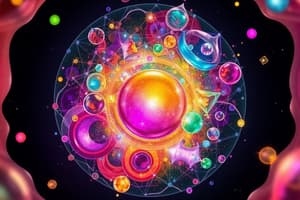Podcast
Questions and Answers
Which of the following statements is true about elements?
Which of the following statements is true about elements?
- Elements can be separated by physical means.
- Elements consist of only one type of atom. (correct)
- Elements contain impurities in their purest form.
- Elements can be a mixture of different types of atoms.
What distinguishes compounds from elements?
What distinguishes compounds from elements?
- Compounds do not have impurities.
- Compounds consist of only one type of atom.
- Compounds are mixtures of different elements.
- Compounds are chemically bonded combinations of elements. (correct)
How can mixtures be separated?
How can mixtures be separated?
- By forming new compounds
- By changing their color
- Through chemical reactions
- By filtration or distillation (correct)
Which type of mixture can be classified as a solution?
Which type of mixture can be classified as a solution?
What is the defining characteristic of pure compounds?
What is the defining characteristic of pure compounds?
What is the process of passing a mixture through a screen with closely spaced holes to separate particles of different sizes?
What is the process of passing a mixture through a screen with closely spaced holes to separate particles of different sizes?
Which method involves allowing one immiscible liquid to be poured off from the other to separate them?
Which method involves allowing one immiscible liquid to be poured off from the other to separate them?
What technique separates mixtures based on the polarity of the components?
What technique separates mixtures based on the polarity of the components?
When a solid is directly converted to its gas phase without passing through the liquid phase, what separation method is being used?
When a solid is directly converted to its gas phase without passing through the liquid phase, what separation method is being used?
Which method collects solid particles by passing a liquid mixture through a filter medium?
Which method collects solid particles by passing a liquid mixture through a filter medium?
Study Notes
Understanding the Purity of Matter Around Us
The physical world we inhabit is composed of countless substances, each with unique properties. As we delve into the compositions of these substances, it's crucial to grasp the concept of purity, a fundamental aspect of matter around us. In this exploration, we'll examine elements, compounds, mixtures, solutions, and the techniques used to separate them.
Elements
Elements are the most basic form of matter, consisting of only one type of atom. For example, gold, hydrogen, and iron are all elements. In their purest form, elements do not contain any impurities. However, due to human intervention, natural processes, or other factors, impurities can be present.
Compounds
Compounds are substances made up of two or more chemical elements chemically bonded together. For instance, table salt (NaCl) is a compound composed of sodium (Na) and chlorine (Cl). Pure compounds do not contain any impurities.
Mixtures
Mixtures are combinations of two or more substances that do not react chemically and can be separated by physical means. For example, a mixture of water and sand or a mixture of salt and sugar. Mixtures may or may not be pure, depending on the presence of impurities.
Solutions
Solutions are homogeneous mixtures in which one substance is uniformly dispersed throughout another. A common example is a sugar solution. Pure solutions do not contain any impurities, and the solute (the dissolved substance) is present in a specific concentration.
Separating Techniques
Various methods can be employed to separate or purify mixtures, including:
-
Sieving: This involves passing a mixture through a screen with closely spaced holes, allowing particles of different sizes to be separated.
-
Filtration: A liquid mixture is passed through a filter medium, allowing solid particles to be removed and collected as a solid deposit.
-
Decantation: This method separates two immiscible liquids by allowing one liquid to be poured off from the other.
-
Evaporation: By applying heat to a mixture, the more volatile component evaporates, leaving the less volatile component behind.
-
Distillation: This is a more advanced form of evaporation, where the vaporized component is cooled and then condensed.
-
Crystallization: When dissolving a solid in a solvent, cooling the solution causes the solid to separate as a pure solid.
-
Chromatography: This technique separates mixtures based on the polarity of the components.
-
Sublimation: This process involves the direct conversion of a solid to its gas phase without passing through the liquid phase.
-
Magnetic separation: This method separates mixtures containing magnetic and non-magnetic components.
Understanding the underlying concepts of elements, compounds, mixtures, solutions, and separation techniques is essential for appreciating the purity of matter around us. By using this knowledge, we can better leverage the natural world for our needs, enhancing our understanding of the physical sciences and beyond.
Studying That Suits You
Use AI to generate personalized quizzes and flashcards to suit your learning preferences.
Description
Dive into the essence of matter purity by understanding elements, compounds, mixtures, solutions, and separation techniques. Explore the characteristics of pure substances and the methods used to separate impurities from mixtures.




